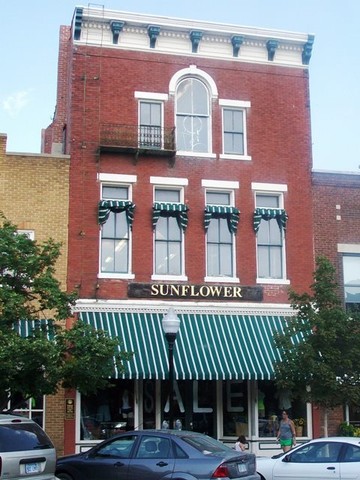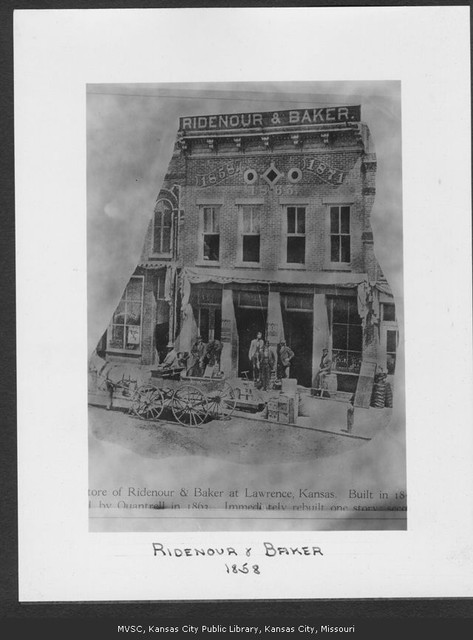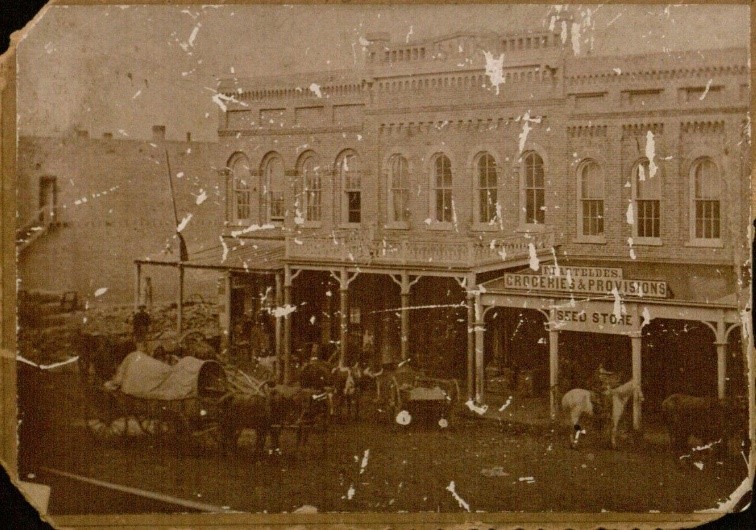Ridenour & Baker Store (Bartelds Seed Company)
Introduction
Text-to-speech Audio
This historic Lawrence structure was one of the first to be rebuilt following Quantrill's Raid in 1863 and was home to the Ridenour & Baker grocery store between 1858 and 1888. The building was later home to the Bartelds Seed Company and has been home to Sunflower Outdoor and Bike for the past fifty years. Friedo Barteldes came to Lawrence in 1860 from Germany and opened a bakery that later transitioned into a seed house, serving the community for 100 years.
Images
2014 photo: Ridenour & Baker Building, now operating as the Sunflower Outdoor and Bike store

Ridenour & Baker Building in 1858 prior to Quantrill's raid

Barteldes Groceries & Provisions and Seed Store, 1864.

Backstory and Context
Text-to-speech Audio
Friedo Barteldes emigrated from Germany and moved to Lawrence with his wife Josephine in 1860, one year before the start of the U.S. Civil War. Barteldes operated a bakery on Massachusetts Street. However, Confederate General William Quantrill (who once lived in Lawrence under an alias) and 400 of his guerrilla-type soldiers rode into town on the morning of August 21, 1863, and burned much of the city, killing more than 160 people. The raid terrorized the people, made widows of more than eighty women, and included a blazing fire that destroyed at least seventy-five buildings that lined Massachusetts Street, including the Ridenour-Baker Building.
Quantrill's Raid was a deadly massacre of civilians by pro-slavery partisans who used the conflict during the territorial period and Civil War as a pretext to commit their crimes. Quantrill and his raiders also resented Free Staters who founded and later controlled Lawrence, and they came from mostly pro-slavery communities in nearby Missouri. In the early years of Kansas Territory, Lawrence had a reputation for being an anti-slavery stronghold. During the war Union regiments ("Jayhawkers") ordered to control guerrilla troops and raid Confederate-friendly Missouri towns regularly stayed in Lawrence. Quantrill's men were also motivated by the idea of vengeance, as eight days before Quantrill's Raid, a women's prison in Kansas City mysteriously collapsed, killing female relatives of the guerrillas.
As the historical marker outside the building notes, Peter Ridenour and Harlow Baker were the first shop owners on Massachusetts Street to rebuild, and reports at the time indicated that the repair work only took around one week to complete. The pair later created a thriving grocery business in Kansas City's West Bottoms.
Frederick W. Barteldes later operated a vast seed retail business in the structure and was one of the most well-known and beloved Lawrence residents of the early 20th century. Fire struck again in 1904, and the Barteldes family rebuilt the original two-story building and added a third floor. The seed company that would become the successful Kansas Seed House, the largest seed firm west of the Mississippi, employed four traveling salespeople and more than fifteen on-site workers. In 1906, the Kansas Seed House was incorporated as the Barteldes Seed Company and expanded to Denver and Oklahoma City locations; the company's headquarters moved to Denver in 1961.
Cite This Entry
Powers, Mathew and Clio Admin. "Ridenour & Baker Store (Bartelds Seed Company) ." Clio: Your Guide to History. January 24, 2024. Accessed April 6, 2025. https://theclio.com/tour/1397/8
Sources
"Celebrating 50 Years of Sunflower Outdoor & Bike." Sunflower Outdoor and Bike. sunfloweroutdoorandbike.com. Accessed January 24, 2024.
https://www.sunfloweroutdoorandbike.com/articles/50-years-pg215.htm
Epps, Kristen. "The Missouri-Kansas Conflict,1855-1865: Quantrill's Raid on Lawrence." Civil War on the Western Border. civilwaronthewesternborder.org. Accessed January 24, 2024. https://civilwaronthewesternborder.org/encyclopedia/quantrills-raid-lawrence#:~:text=William%20Quantrill's%20raid%20on%20the,and%20190%20men%20and%20boys.
Fischer, William. "Ridenour & Baker Building, 1858-1888." The Historical Marker Database. hmdb.org. February 10, 2023. https://www.hmdb.org/m.asp?m=76303.
Huff, Meredith. "Seedy Business: History of the Barteldes Seed Company." The University of Kansas Kenneth Spencer Research Library. ku.edu. February 26, 2019. https://blogs.lib.ku.edu/spencer/seedy-business-history-of-the-barteldes-seed-company/.
"I Am Alive." Kansas University Library. ku.edu. Accessed January 24, 2024. https://exhibits.lib.ku.edu/exhibits/show/quantrill/after/alive.
"Kansas Seed Company Lawrence, Kansas." Virtual Horticultural Library. saveseeds.org. Accessed January 23, 2024. http://www.saveseeds.org/company_history/barteldes/index.html.
"Turnhalle Historic Structure Report: Lawrence, Kansas." Lawrence Preservation Alliance. July 25, 2013. https://khri.kansasgis.org/photos_docs/045-3010-01561_17.pdf.
Wolfenbarger, Deon. "Registration Form: Lawrence's Downtown Historical District." National Register of Historic Places. kshs.org. 2003. https://www.kshs.org/resource/national_register/nominationsNRDB/Douglas_LawrenceDowntownHistoricDistrictNR.pdf.
Photographed By William Fischer, Jr., August 2, 2014. https://www.hmdb.org/m.asp?m=76303
Kansas City Public Library: https://kchistory.org/image/ridenour-baker-grocery-company-1
Douglas County Historical Society Manuscript Collections: https://blogs.lib.ku.edu/spencer/seedy-business-history-of-the-barteldes-seed-company/

